Photo / Video News & Reviews
Nauticam Announces Housing for the Panasonic GX8
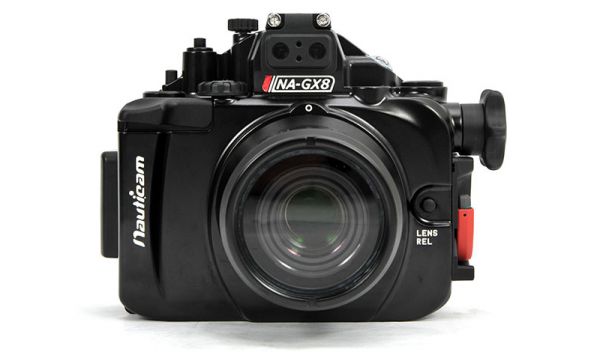
Nauticam has introduced the latest in its line of underwater camera housings, the NA-GX8, designed specifically for the Panasonic GX8.
The Panasonic Lumix DMC-GX8
Panasonic continues to push the m4/3 envelope, this time with a new sensor that breaks into the 20 megapixel realm, the highest of any m4/3 sensor to date. This camera is aimed squarely at the enthusiast, with it’s excellent image quality, higher resolution, rangefinder styling and 4K video capture. It is an ideal camera for the underwater photographer/videographer.
The GX8 also features “Dual IS”, i.e. image stabilization in both the lens and sensor; working in concert to handle camera shake better than any previous Panasonic camera. More importantly for underwater image makers – focus has been improved considerably, especially in low light. Panasonic claims quick and accurate autofocus at -4EV. This should make focusing easier underwater, given that u/w scenes are typically darker than terrestrial scenes. The camera body features 3 command dials, including a dedicated exposure compensation dial.
Panasonic Lumix DMC-GX8 Features
- Rangefinder-style mirrorless
- Sensor CMOS m4/3 5184 x 3888 (20 megapixels)
- Auto, 200-25600 (expands down to 100) ISO
- Articulated LCD
- 1.1M dot OLED
- 2.4M dot EVF
- 4K or HD video, mpeg4 or AVCHD
- 4K burst photo modes at 30fps
- 6 fps still photo with continuous AF
Nauticam NA-GX8
The pioneering features of the earlier Nauticam housings are apparent with the simple but secure rotating housing latch and superb progressive shutter release providing optimal “feel”. The NA-GX8 also sports some of Nauticam’s latest technology with the port locking latch that replicates the famous Nauticam DSLR port latch – making housing port changes easier than ever.
The new housing takes full advantage of the Panasonic’s many features and allows easy one handed operation of key controls like the three command dials and the video record button. The NA-GX8 supports 7 programmable buttons on this camera, easily accessible from the housing. The sculpted shutter release makes “half-press” focus incredibly easy. For fans of “thumb focus” (moving the autofocus from half-press of the shutter to a button operated by the right thumb), this is fully supported with the AF/AEL button.
Attention to detail is everywhere, from the comfortable thumb rest on the right to the large knurled command wheels and zoom/focus knob. Video is easily accessed; the video button is given special treatment, being larger, concave and red in color. For tripod use, the housing features two standard 1/4″ 20 tripod holes, or is also tripod ready when using the Flexitray W camera tray.
Strobe firing is supported via fiber optic through the use of the optional Panasonic DMW-FL70-S flash unit. Accurate automatic flash exposure (TTL flash) is easily accomplished via strobes like the Inon Z-240 or S-2000.
The NA-GX8 comes standard with the Nauticam vacuum system electronic built in. By default, it serves as a audible and visual leak detector, but add a Nauticam M14 Vacuum Valve, (25611) and it becomes a vacuum check system – early warning for problems with watertight integrity – which means peace of mind when shooting underwater.
Each control on the housing is clearly labeled, making it easy to learn the system. Milled from solid aluminum, the housing is rated to 100m/330ft depth, and is rugged and ready for use.
Lenses
It’s all about the glass – lenses are the key to terrific photography. The m4/3 system supports a large range of high quality lenses produced by Panasonic (partnering with Leica), Olympus and third parties. Several lenses that perform extremely well underwater are available (and reasonably priced). Some examples:
- Olympus M.ZUIKO DIGITAL ED 12-50mm F3.5-6.3 EZ: The ultimate jack of all trades tool, this lens covers a very usable mid range, and features a unique macro mode. Shoot dolphins and nudibranchs on the same dive!
- Panasonic Lumix G Fisheye 8mm/F3.5: This 180º fisheye lens focuses close and is razor sharp. Combines with a small port, there is no better CFWA (close focus wide angle) option on the planet.
- Olympus M.ZUIKO DIGITAL ED 60mm f/2.8 Macro: This is an ideal macro lens for m4/3, and by adding the Nauticam CMC, it becomes a super macro monster. Imagine filling the entire width of the frame with something only 8mm wide!
- Panasonic Lumix G Vario 7-14mm f/4.0 ASPH: The 7-14mm is a rectilinear lens, ideal for shooting people or sharks or wrecks… subjects where the fisheye distortion is not welcome. On the wide end, this lens 114º wide, ideal for getting close to subjects to reduce the amount of water shot through. But a zoom gets to 75º – ideal for reaching out to that subject that is a little more skittish. The very similar Olympus M.Zuiko Digital ED 9-18mm f/4.0-5.6 can serve the same basic role at a lower cost.
There are many more options for the underwater photographer, including any of the several 14-42mm options, the Panasonic Lumix G X VARIO 12-35mm F2.8 ASPH. POWER O.I.S., Olympus M.ZUIKO DIGITAL ED 12-40mm f/2.8 PRO, Panasonic Lumix G Vario 12-32mm f/3.5-5.6 ASPH, Panasonic Lumix G 14mm F2.5 ASPH, and the Leica DG Macro Elmarit 45mm F2.8 ASPH. Olympus also recently released two new wide angle lenses that are superb for underwater use, the Olympus M.ZUIKO Digital ED 8mm f/1.8 Fisheye PRO and the Olympus M.ZUIKO Digital ED 7-14mm f/2.8 PRO.
Nauticam Vacuum Check System
The Nauticam vacuum check and leak detection system electronics are included with the NA-GX8 as standard equipment. Combined with an optional vacuum valve, this monitoring system provides constant updates on the water tight and safe to dive status of the housing. The operator can, at a glance, instantly see the water tight and safe-to-dive status of the housing. A simple coded LED lighting system lets the user know that the vacuum is solid, or that the housing is losing vacuum. Leak detection is built into the same circuit, so if there is water intrusion, an audible and visual indication will occur. The NA-GX8 features a 2nd bulkhead port (M14) specifically for installing optional vacuum valves, leaving the other bulkhead port for HDMI, sync cables and other accessories.
The NA-G8X, fitted with vacuum valve; the green light indicates a consistent vacuum and is an extra assurance that the system is watertight. Show with optional Flexitray, demonstrating the brackets and off board shutter release.
 |
 |
| Inon Z-240 Strobe | Panasonic DMW-FL70-S Flash |
Flash Connectors for Inon S-TTL
Reliable automatic flash exposure is available with the NA-GX8 and a variety of optically fired flashes. The Inon Z-240, D-2000, S-2000 strobes provide automated lighting, precisely reproducing the camera’s onboard flash at a proportionally greater intensity. This system yields accurate automatic TTL flash performance – even in manual mode – with no electrical sync cables to flood. The NA-GX8 comes fiber optic ready and accepts standard Sea & Sea style bushing connections.
Strobes can be attached to the housing via optional strobe mounting balls secured to the handles of the Nauticam accessory tray systems or a single strobe mounting ball location on the housing. The housing also features an M10 mounting hole and a cold-shoe mount for a focus light or other accessory mounting options.
Recommended Accessories
- 180º Enhancing Viewfinder for Mirrorless Housings (32204)
- 45º Enhancing Viewfinder for Mirrorless Housings (32205)
- Patent Pending Compact Macro Converter (CMC) (81301)
- M14 Vacuum Valve (25611)
- Complete line of flat/dome ports for all major lenses, available in acrylic and glass
- Fiber optic cables for Inon (26214) and Sea&Sea (26215)
- FlexiTray (71207) or FlexiTray Wide (71209) and Right Handle (71208)
- Full line of mounting accessories for lighting, including mount balls, strobe adapters, arms, clamps, and specialty items
- Multiple styles of lanyards
- Comfortable handstrap available in two lengths (36316 and 36323)
- Lens holders, including flip-up
NA-GX8 fitted with the optional 45º enhancing viewfinder.
Viewfinders
The standard optical glass viewfinder is very good and travel friendly, but many photographers prefer the ease of a magnified viewfinder with adjustable diopter. Nauticam produces a special version of its enhanced viewfinders made specifically for it’s new line of mirrorless camera housings. Whether it’s the “straight” 180º enlarging viewfinder (32204) or the 45º angled enlarging viewfinder (32205), the enlarged and brighter view enables easier focusing. Both viewfinders have high quality optics, and allow bright viewing of the entire image. A patented external dioptric adjustment allows personal adjustment to a sharp-as-a-tack standard underwater and viewfinder changes can be executed in less than 30 seconds without using tools.
Details and Specifications
- Weight: 1.17kg
- Dimensions: 206mm (W) x 154mm (H) x 99mm (D)
- Depth Rating: 100m
Model Number: 17711
USA Retail Price: $1600
Shipping: Sept 29, 2015
More information is available at www.nauticamusa.com and www.nauticam.co.uk.
Blogs
Diver Discovering Whale Skeletons Beneath Ice Judged World’s Best Underwater Photograph
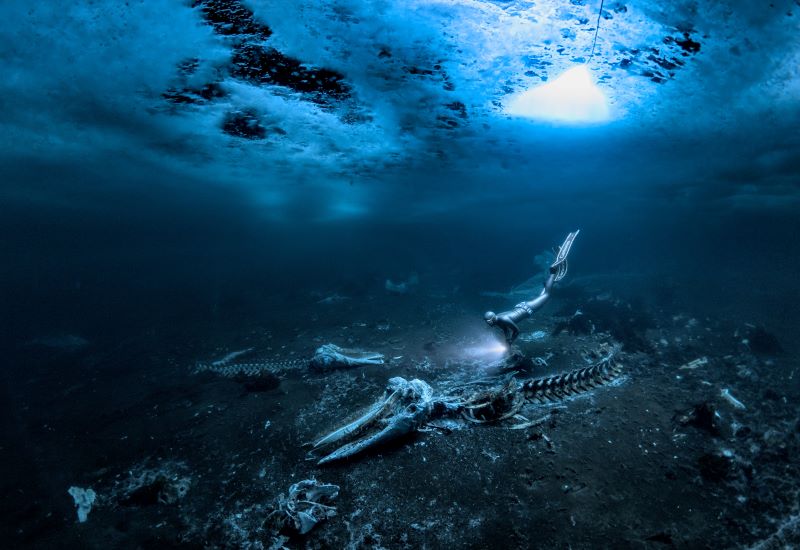
An emotive photograph showing a freediver examining the aftermath of whaling sees
Alex Dawson from Sweden named Underwater Photographer of the Year 2024. Dawson’s
photograph ‘Whale Bones’ triumphed over 6500 underwater pictures entered by underwater
photographers from around the world.
“Whale Bones was photographed in the toughest conditions,” explains chair of judging
panel Alex Mustard, “as a breath-hold diver descends below the Greenland ice sheet to bear
witness to the carcasses. The composition invites us to consider our impact on the great
creatures of this planet. Since the rise of humans, wild animals have declined by 85%. Today,
just 4% of mammals are wildlife, the remaining 96% are humans and our livestock. Our way
needs to change to find a balance with nature.”
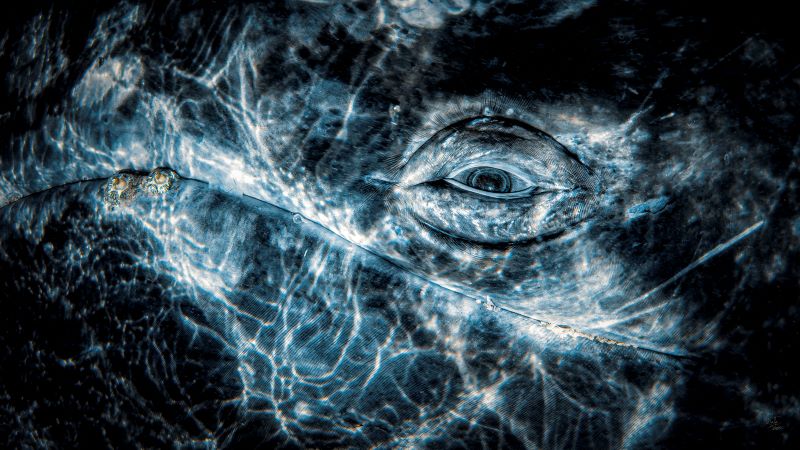
Photo: Rafael
Fernandez Caballero
Whales dominated the winning pictures this year with Spanish photographer Rafael
Fernandez Caballero winning two categories with his revealing photos of these ocean giants:
a close up of a grey whale’s eye and an action shot of a Bryde’s whale engulfing an entire bait
ball, both taken in Magdalena Bay, Baja California, Mexico. Fernandez Caballero took ‘Grey
Whale Connection’ while drifting in a small boat, holding his camera over the side in the water
to photograph the curious whale. ‘The End Of A Baitball’ required Fernandez Caballero to dive
down and be in exactly the right place at the moment the whale lunged. “The photo shows
the high speed attack,” he said, “with the whale engulfing hundreds of kilograms of sardines
in one bite — simply unforgettable to see predation on such a scale.”
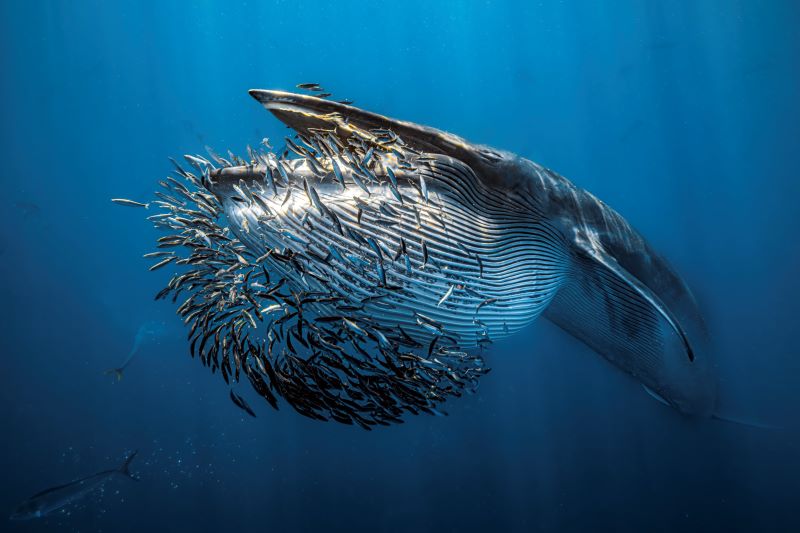
Photo: Rafael
Fernandez Caballero
Lisa Stengel from the United States was named Up & Coming Underwater Photographer of the Year 2024 for her image of a mahi-mahi catching a sardine, in Mexico. Stengel used both a very fast shutter speed and her hearing to catch the moment. “If you listen there’s an enormous amount of sound in the ocean,” she explained. “The action was too fast to see, so I honed in on the sound of the attacks with my camera to capture this special moment.”
“It is such an exciting time in underwater photography because photographers are capturing such amazing new images, by visiting new locations and using the latest cameras,”
commented judge Alex Mustard. “Until this year I’d hardly ever see a photo of a mahi mahi,
now Lisa has photographed one hunting, action that plays out in the blink of an eye.”
The Underwater Photographer of the Year contest is based in the UK, and Jenny Stock,
was named as British Underwater Photographer of the Year 2024 for her image “Star
Attraction”, which finds beauty in species of British wildlife that are often overlooked.
Exploring the west coast of Scotland, Stock explained “in the dark green depths my torch
picked out the vivid colours of a living carpet of thousands of brittle stars, each with a
different pattern. I was happily snapping away, when I spotted this purple sea urchin and I
got really excited.”
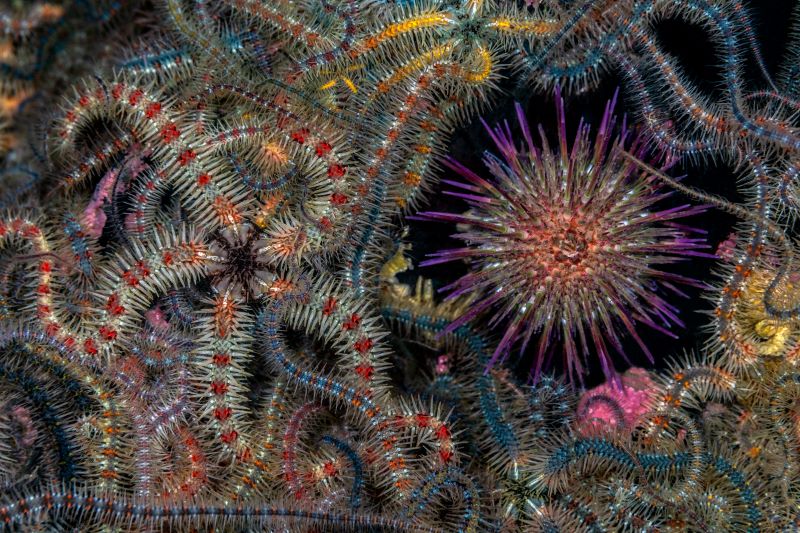
Photo: Jenny Stock
In the same contest, Portuguese photographer, Nuno Sá, was named ‘Save Our Seas
Foundation’ Marine Conservation Photographer of the Year 2024, with his photo ‘Saving
Goliath’, taken in Portugal. Sá’s photo shows beachgoers trying to save a stranded sperm
whale. The picture gives us hope that people do care and want to help the oceans, but also
warns us that bigger changes are needed. “The whale had been struck by a ship and its fate
was sealed,” explains Sá. “An estimated 20,000 whales are killed every year, and many more
injured, after being struck by ships-and few people even realise that it happens.”
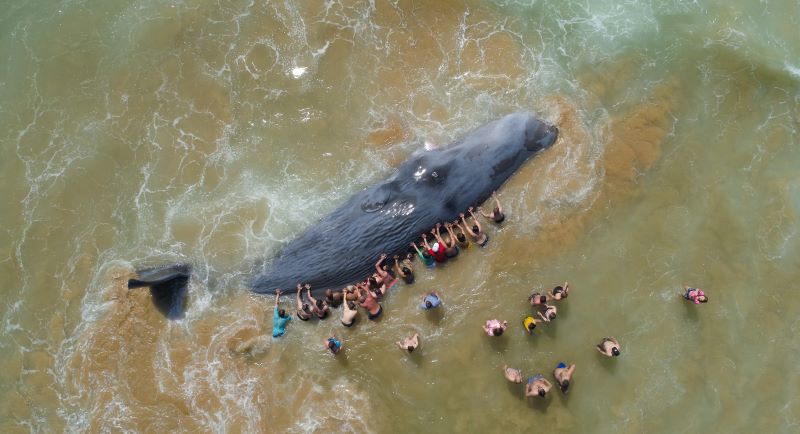
Photo: Nuno Sá
More winning images can be found at www.underwaterphotographeroftheyear.com.
About Underwater Photographer of the Year
Underwater Photographer of the Year is an annual competition, based in the UK, that celebrates photography beneath the surface of the ocean, lakes, rivers and even swimming pools, and attracts entries from all around the world. The contest has 13 categories, testing photographers with themes such as Macro, Wide Angle, Behaviour and Wreck photography, as well as four categories for photos taken specifically in British waters. The winners were announced in an award ceremony in Mayfair, London, hosted by The Crown Estate. This year’s UPY judges were experienced underwater photographers Peter Rowlands, Tobias Friedrich and Dr Alexander Mustard MBE.
Header image: Underwater Photographer of the Year 2024 winner Alex Dawson
News
World’s Best Underwater Photographers Unveil Breathtaking Images at World Shootout 2023
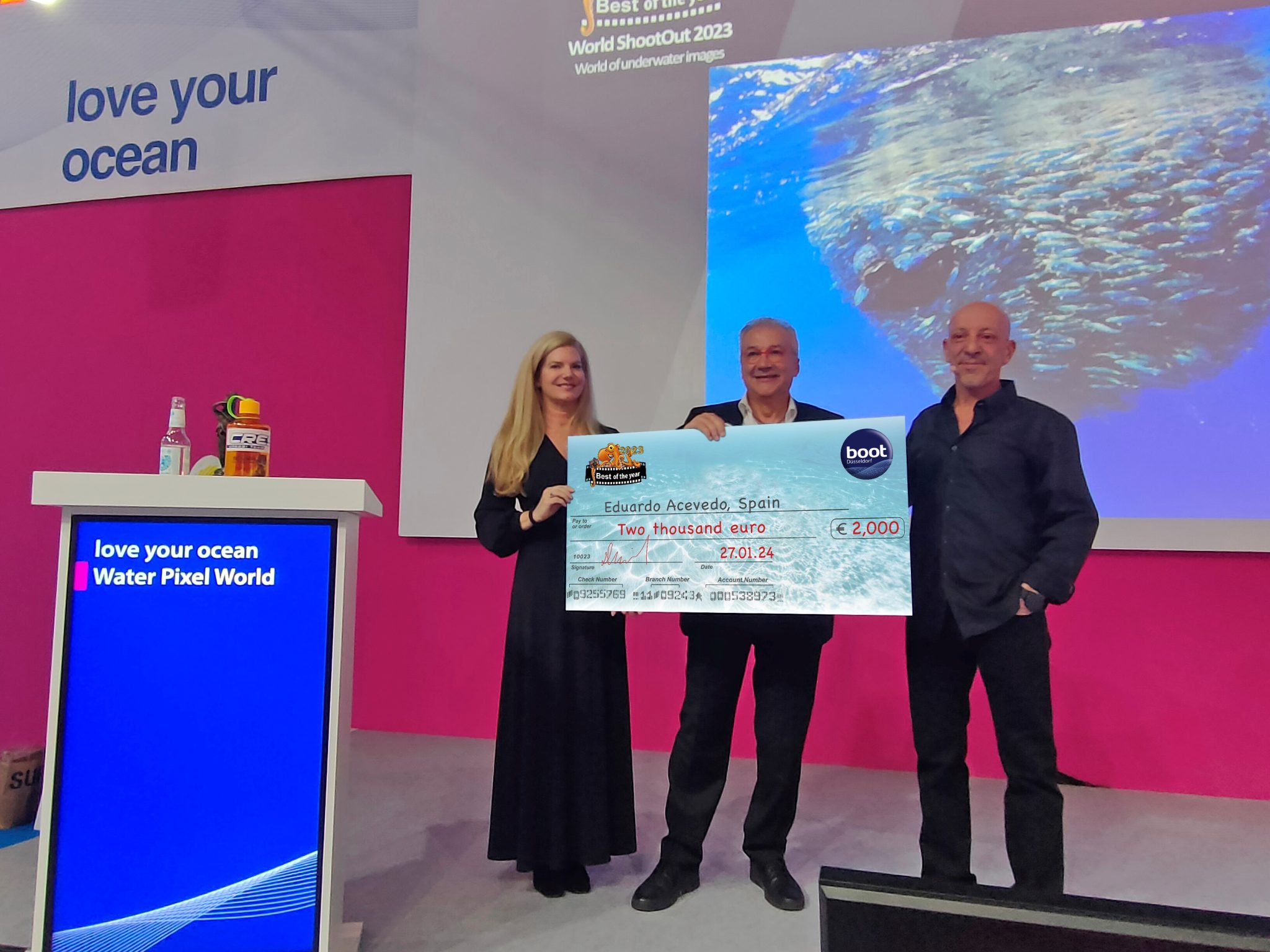
The winners of the prestigious World Shootout 2023 underwater photography competition were announced at this year’s BOOT Show, captivating audiences at the world’s largest diving and water sports exhibition in Dusseldorf, Germany. Hundreds of photographers from 54 countries competed across nine categories, pushing the boundaries of creativity and technical skill.
Grand Prize Winners
- Picture of the Year: Spanish photographer Eduardo Acevedo “secured” the top Honor with the prestigious prize the “boot Dusseldorf Director’s Prize, earning an Andromeda statuette and a €2,000 cash prize.
- Best 5 Images Portfolio: Luc Rooman from Belgium triumphed in this category, winning a dream 4-week diving trip for two to Papua New Guinea, valued at $18,900.
- Amateur Photographer: Alexandra Ceurvorst from the USA impressed the judges with her talent, taking home the 1,000 € cash prize award.
Celebrating Diversity and Innovation
This year’s competition saw 11,680 entries from 964 photographers, showcasing a remarkable spectrum of skills and perspectives. From the intricate wonders of Macro photography to the beauty of “Black Water”, the “Underwater Fashion” category added a touch of artistry and innovation, while the ever-important ” Environmental & Conservation” category served as a powerful reminder of the need to protect these fragile ecosystems.
Looking Ahead: AI and Ocean Conservation
World Shootout founder and producer David Pilosof unveiled an exciting addition for the 2024 competition: this year the Environmental category will be focusing on the impact of plastic on our oceans and future.
This category will embrace the potential of AI or other editing software as a tool to amplify the conservation message.
Entrants will submit campaigns of three original underwater photographs dealing with plastic pollution, along with their final AI assistance processing. This innovative approach encourages artistic expression while raising awareness about a critical environmental issue.
Explore the Stunning Collection
Discover the complete album of competition entries by clicking here.
For Low-resolution photos of finalist entries in eight categories, click here.
-

 News3 months ago
News3 months agoHone your underwater photography skills with Alphamarine Photography at Red Sea Diving Safari in March
-

 News3 months ago
News3 months agoCapturing Critters in Lembeh Underwater Photography Workshop 2024: Event Roundup
-

 Marine Life & Conservation Blogs2 months ago
Marine Life & Conservation Blogs2 months agoCreature Feature: Swell Sharks
-

 Blogs2 months ago
Blogs2 months agoMurex Resorts: Passport to Paradise!
-

 Blogs2 months ago
Blogs2 months agoDiver Discovering Whale Skeletons Beneath Ice Judged World’s Best Underwater Photograph
-

 Gear Reviews3 months ago
Gear Reviews3 months agoGear Review: Oceanic+ Dive Housing for iPhone
-

 Marine Life & Conservation2 months ago
Marine Life & Conservation2 months agoSave the Manatee Club launches brand new webcams at Silver Springs State Park, Florida
-

 News3 months ago
News3 months agoWorld’s Best Underwater Photographers Unveil Breathtaking Images at World Shootout 2023
















